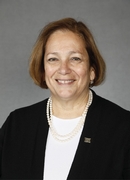
Jackson
RSNA President Valerie P. Jackson, MD, will open RSNA 2019 with her President's Address, "A Matter of Perspective: Putting a New Lens on Our Patient Interactions." She will speak about the importance of human interactions between physicians and patients and how technologic innovation in medicine makes that connection more relevant today than ever. The key, she says, is in changing our perspectives and approaches — toward patients, referring physicians and our own profession — and reimagining new ways of working together.
Daily Bulletin: What do you see as the greatest challenges facing radiologists today?
Valerie P. Jackson, MD: Radiologists continue to be challenged by the pressure of large caseloads and quick turnaround times. This makes it seem difficult to fully commit to patient-centered practice. The caseloads aren't going to disappear, so we need to widen our perspective to focus on the benefits of communicating with patients and forging stronger alliances with referring physicians.
DB: How can a shift in perspective toward patients help radiologists facing ever-growing caseloads?
VPJ: Patients are playing a more interactive role in their medical care, and recent studies have shown that patients want more contact with their radiologists.
While the transition to patient-centered care has been easier for some than others, the paradigm shift offers several advantages. We know that diagnostic radiologists who are more patient-centered are less vulnerable to burnout and are more likely to be recognized as trusted, integral members of their patients' health care team.
DB: In what ways can technologic innovation in medical imaging help radiologists add value?
VPJ: A number of changes in radiology practice and the overall health care environment have made patient interaction a critical and timely component of radiologic care. The emergence of artificial intelligence applications that can be trained to handle a variety of time-consuming tasks, for instance, has the potential to free radiologists to devote more time to patient interaction. It's an exciting time in the specialty.
DB: What can all radiologists do to increase their visibility to patients?
VPJ: Patient-centered care means more than simply talking to patients. While patient communication plays a substantial role in the value-based care model, radiologists can increase visibility and improve patient interaction in a variety of ways. For example, adapting workflow to better accommodate patient preferences, developing patient-friendly radiology reports and maintaining a social media presence are just few simple ways to enhance patient engagement.
DB: What role do referring physicians play in this shift?
VPJ: We've spent a great deal of time asking ourselves what our patients want. We need to be equally dedicated when it comes to building relationships with referring physicians. We must take the time to engage their trust and open the lines of communication to determine how best to serve the interests of our patients together and ensure radiologists are vital members of the health care team.
DB: What are you most looking forward to at RSNA 2019?
VPJ: During my time on the Board, RSNA has emerged as a leader in artificial intelligence research and education with a host of initiatives that help radiologists understand how data and deep learning applications can be used to improve patient care.
I am looking forward to visiting the expanded AI Showcase as well as the redesigned RSNA Deep Learning Lab and the new hands-on workshops. I also look forward to learning from my colleagues through the innovative research across the specialty that will be presented throughout the week.

